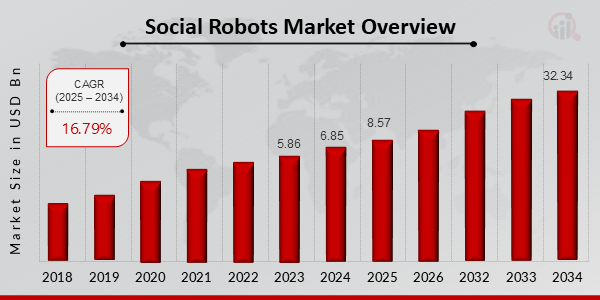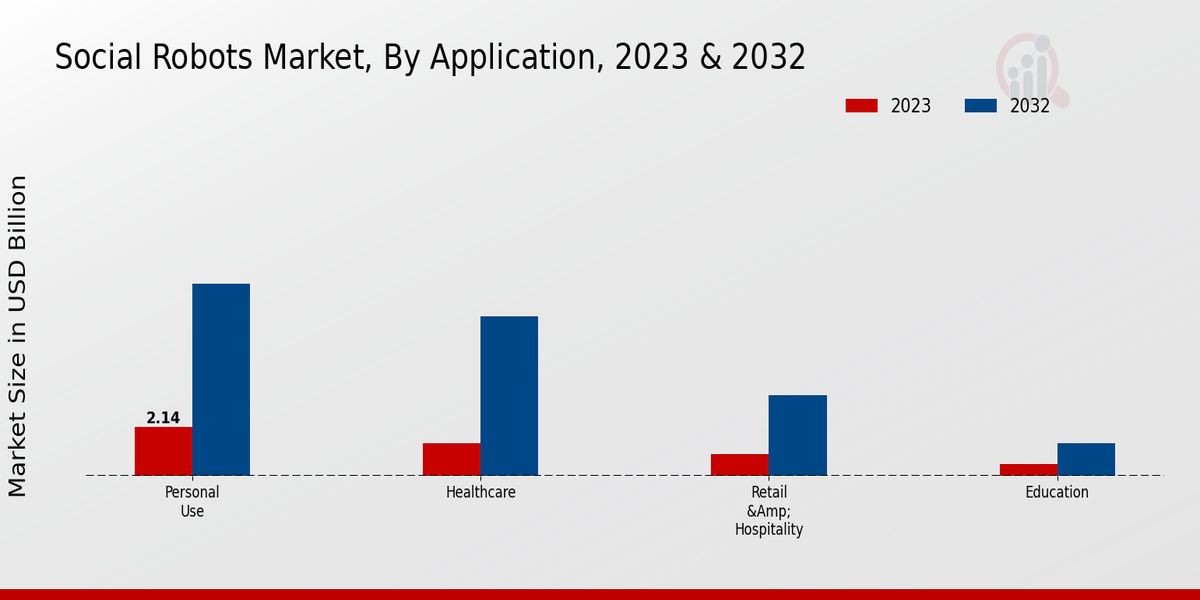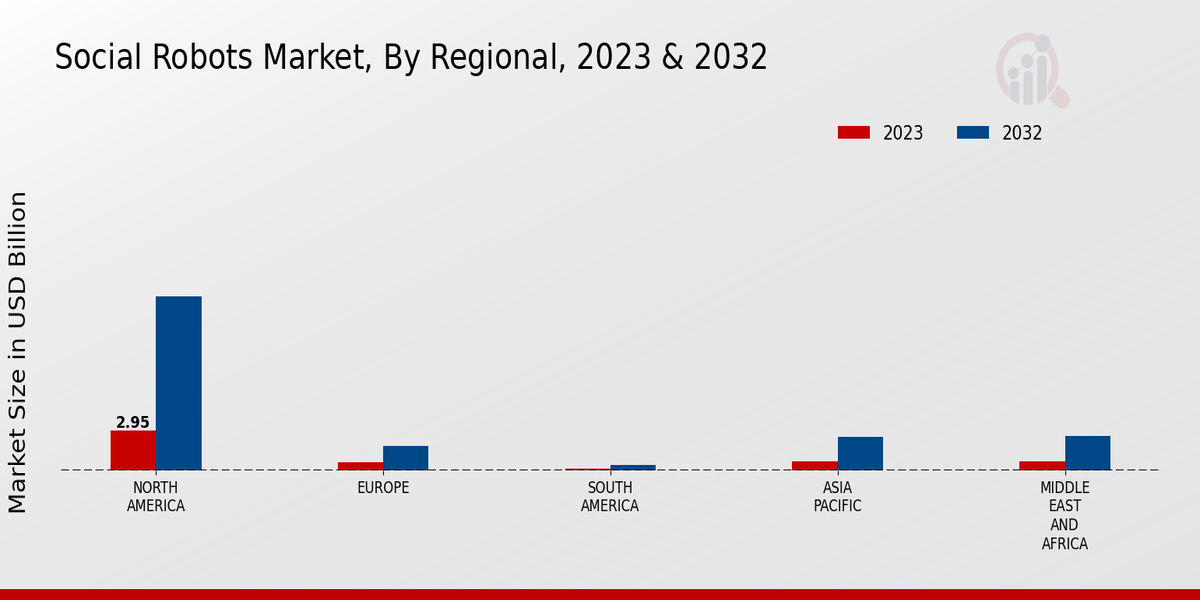Social Robots Market Overview
Social Robots Market is projected to grow from USD 8.57 Billion in 2025 to USD 32.34 Billion by 2034, exhibiting a compound annual growth rate (CAGR) of 16.79% during the forecast period (2025 - 2034). Additionally, the market size for Social Robots Market was valued at USD 6.85 billion in 2024.
Key Social Robots Market Trends Highlighted
The demand for social robots is escalating, driven by the surging adoption of artificial intelligence (AI) and the escalating need for companionship and assistance in various domains. These robots offer an array of benefits, including enhanced social interactions, improved healthcare outcomes, and increased productivity in workplaces.
Key market drivers include the escalating demand for personalized experiences, the growing prevalence of chronic diseases, and the rising adoption of AI in various sectors. Social robots offer the potential to address social isolation, aid individuals with disabilities, and enhance educational experiences.
Recent market trends encompass the integration of advanced AI algorithms, the development of humanoid robots with enhanced social skills, and the increasing use of social robots in healthcare and educational settings. Furthermore, the growing focus on ethical considerations and data privacy regulations is shaping the market landscape, ensuring the responsible and ethical deployment of social robots.
Figure1: Social Robots Market Overview , 2025 - 2034 (USD Billion)

Source: Primary Research, Secondary Research, MRFR Database and Analyst Review
Social Robots Market Drivers
Growing Demand for Personalized Customer Service
One reason the social robots market will expand notable in the forthcoming years is the increasing demand for personalized customer service. Companies are currently using social robots to provide personalized support in an attempt to improve customer experiences and strengthen relationships with buyers. Accordingly, social robots can engage buyers naturally and intuitively, offering individual recommendations, addressing buyer questions, and providing real-time help.Drawing on the sentiment of the customer, their preferences, and the previous issues they wanted help with is another way the social robots provide personalized help. The use of social robots thus culminates in highly individualized experiences that increase customer satisfaction and boost loyalty. Since more companies in different industries, such as healthcare, hospitality, education, and retail, are likely to adopt social robots, given the benefits the customer service tool offers, the consumption growth of the product in question is likely to be significant.
Advancements in Artificial Intelligence and Machine Learning
Advances in artificial intelligence and machine learning are driving the social robot market. AI and ML technologies help these robots acquire improved cognitive capabilities, which allow them to learn from experiences, adapt to different situations, and perform better. Since they can handle a significant amount of data, they can easily detect patterns and offer relevant responses and solutions to customers. From this point of view, these technologies help make customer service more intelligent and efficient.Additionally, advances in natural language processing allow social robots to engage in more human-like and natural conversations with customers, which enhances the quality of services delivered. The integration of AI and ML technologies is expected to drive the social robots market further because it enables businesses to design more advanced solutions that can address their constantly changing needs and requirements.
Rising Adoption in Healthcare and Education
The social robots industry is experiencing increased adoption in healthcare and education. Social robots used in healthcare are assisting patients, the elderly, and disabled people. They can monitor patients’ vital signs and medication schedules, offer friendship and emotional therapy when needed, help track health conditions, and communicate with the medical staff. In education, the robots are taking on the role of teaching assistants.Social robots create more memorable learning experiences and adaptive learning paths. They can craft engaging content and adjust formal or informal learning procedures. Promoting adaptive learning experiences, social robots can offer personal feedback and help teachers design lesson plans. As the adoption of social robots continues to increase in the healthcare and education sectors, the industry is anticipated to grow as well.
Social Robots Market Segment Insights
Social Robots Market Application Insights
The Social Robots Market segmentation by application includes Personal Use, Healthcare, Retail Hospitality, and Education. Among these segments, the Personal Use segment is anticipated to hold the largest market share in 2023. The rising adoption of social robots as companions and assistants in households is expected to be the key factor contributing to the segment’s growth. The Healthcare segment is expected to experience significant growth in the future years. The increasing demand for social robots in elderly care, rehabilitation, and therapy is likely to be the major contributing factor.
The Retail Hospitality segment is also predicted to exhibit substantial growth as social robots find applications in customer service, product demonstrations, and entertainment. The Education segment is anticipated to witness steady growth as social robots are increasingly used as tools for education, making learning and teaching interesting. Based on market size, the Social Robots Market for Personal Use is estimated to reach USD 6.3 billion by 2024 at a CAGR of 18.5%. The Healthcare segment is anticipated to be worth USD 4.2 billion by 2024 at a CAGR of 19.3%.
The Retail Hospitality segment is expected to be worth USD 2.8 billion by 2024, registering a CAGR of 17.8%. The Education segment is likely to be worth USD 1.5 billion by 2024 at a CAGR of 16.5%. Key factors estimated to drive the growth of the Social robot market include the rising demand for companionship and assistance, advances in artificial intelligence and robotics, and the growing adoption of social robots in various end-use industries. However, the high price of social robots and the associated privacy and security issues are possible constraints on the growth of the market.
Figure2: Social Robots Market, By Application, 2023 & 2032 (USD billion)

Source: Primary Research, Secondary Research, MRFR Database and Analyst Review
Social Robots Market Robot Type Insights
The Social Robots Market is segmented by Robot Type into Humanoid Robots, Animal Robots, Service Robots, and Companion Robots. Among these, the Service Robots segment is expected to hold the largest market share in 2023, owing to the increasing demand for robots in healthcare, hospitality, and retail sectors. The Companion Robots segment is projected to witness the highest growth rate during the forecast period, driven by the growing popularity of interactive and emotionally intelligent robots as companions for the elderly and individuals living alone. This growth is attributed to the increasing adoption of social robots in various applications, such as healthcare, education, and entertainment.
Social Robots Market Mobility Insights
The Social Robots Market is segmented based on mobility into stationary, mobile, and semi-mobile robots. Stationary robots are fixed in one location and cannot move independently. Mobile robots can move around freely and are often used for tasks such as navigation, mapping, and delivery. Semi-mobile robots can move around but are limited by a physical tether or connection. The mobility segment is a key factor in determining the functionality and applications of social robots. Stationary robots are typically used in fixed locations such as homes, offices, and hospitals.
They are often used for tasks such as companionship, education, and healthcare. Mobile robots are more versatile and can be used in a wider range of applications, such as retail, logistics, and manufacturing. Semi-mobile robots offer a balance between the two, providing mobility while still being limited by a physical connection. In 2023, the mobile segment accounted for the largest share of the Social Robots Market revenue, with a valuation of USD 2.5 billion. This is due to the increasing demand for mobile robots in various industries, such as healthcare, retail, and manufacturing. The mobile segment is expected to continue to grow at a significant rate in the coming years, driven by the increasing adoption of mobile robots for tasks such as navigation, mapping, and delivery.
Social Robots Market Functionality Insights
The Functionality segment of the Social Robots Market is categorized into Basic Communication, Advanced Communication and Interaction, Emotion Recognition and Expression, and Physical Assistance. Basic Communication robots can engage in simple conversations, while Advanced Communication and Interaction robots can understand and respond to more complex interactions. Emotion Recognition and Expression robots can detect and respond to human emotions, while Physical Assistance robots can perform physical tasks such as carrying objects or providing mobility assistance.
In 2023, the Basic Communication segment held the largest market share at 35.2%, followed by Advanced Communication and Interaction at 28.4%. Emotion Recognition and Expression accounted for 22.1%, and Physical Assistance contributed 14.3%. The market growth for Advanced Communication and Interaction and Emotion Recognition and Expression is expected to be driven by the increasing demand for robots that can engage with humans in more natural and intuitive ways. Physical Assistance robots are also expected to experience significant growth due to the rising demand for robots that can assist with tasks such as healthcare, manufacturing, and logistics.
Social Robots Market Price Range Insights
The Social Robots Market segmentation by price range offers valuable insights into the diverse consumer preferences and market dynamics. The market is categorized into four distinct segments: Low-End ($0-$500): This segment is expected to account for a significant share of the Social Robots Market revenue in 2023, owing to its affordability and accessibility. Low-end social robots are primarily designed for basic companionship and entertainment purposes, catering to budget-conscious consumers. Mid-Range ($500-$1,500): Mid-range social robots offer more advanced features and capabilities compared to low-end models.
They incorporate enhanced sensors, improved processing power, and expanded functionality, making them suitable for a wider range of applications, including education and healthcare. High-End ($1,500-$5,000): High-end social robots are designed to provide sophisticated and personalized experiences. They leverage artificial intelligence (AI) and machine learning (ML) algorithms to enable natural language processing, facial recognition, and emotional intelligence. This segment is expected to witness significant growth as demand for advanced social robots increases.Premium ($5,000 and above): The premium segment represents the top tier of the Social Robots Market, catering to discerning customers who seek cutting-edge technology and unparalleled experiences. These robots offer exceptional performance, design, and customization options, making them highly sought-after in specialized industries such as healthcare and research.
Social Robots Market Regional Insights
The Social Robots Market size is expected to reach around USD 5.02 billion in 2023 and is expected to witness a CAGR of 16.79% during the forecast period of 2024 to 2032. Region-wise, the North American region accounted for the largest revenue share in 2023. This is due to the high adoption of social robots in various sectors such as healthcare, education, and retail. The Asia-Pacific region is expected to grow at the highest CAGR during the forecast period. This is due to the increasing demand for social robots in emerging economies such as China and India.
Figure3: Social Robots Market, By Regional, 2023 & 2032 (USD billion)

Source: Primary Research, Secondary Research, MRFR Database and Analyst Review
Social Robots Market Key Players And Competitive Insights
Major players in Social Robots Market are continuously looking for new and innovative ways to improve their products and services. The leading Social Robots Market players are focusing on developing social robots that are more interactive, autonomous, and user-friendly. They are also working on improving the appearance and design of social robots to make them more appealing to consumers. The Social Robots Market is expected to grow rapidly in the coming years, driven by increasing demand from various sectors such as healthcare, education, and retail.SoftBank Robotics is a leading Social Robots Market player that is known for its innovative humanoid robot, Pepper. Pepper is a social robot that is designed to interact with humans in a natural and intuitive way.
It can recognize human emotions, engage in conversation, and aid with tasks such as navigation and information retrieval. SoftBank Robotics is also working on developing new social robots for various applications, such as healthcare and education.Another leading Social Robots Market player is Hanson Robotics. Hanson Robotics is known for its realistic humanoid robots, such as Sophia and Grace. Sophia is a social robot designed to exhibit human-like intelligence and emotion. It can recognize and respond to human facial expressions and engage in conversation on a variety of topics. Hanson Robotics is also working on developing new social robots for various applications, such as customer service and entertainment.
Key Companies in the Social Robots Market Include
Social Robots Market Industry Developments
Recent developments and current affairs in the Social Robots Market include the increasing adoption of social robots in various sectors such as healthcare, education, and retail due to their ability to provide personalized and engaging experiences. The COVID-19 pandemic has further accelerated the demand for social robots, as they can assist in tasks such as disinfection, temperature screening, and providing companionship to isolated individuals.Key players in the market are focusing on developing advanced social robots with enhanced capabilities, such as improved natural language processing, emotional intelligence, and mobility.
Strategic partnerships and collaborations between technology companies and healthcare providers are also driving innovation in the market.Government initiatives and regulations play a significant role in shaping the development and adoption of social robots. For instance, the European Union has established ethical guidelines for the design and use of social robots to ensure responsible deployment and minimize potential risks.Overall, the Social Robots Market is experiencing rapid growth and is expected to continue expanding in the coming years, driven by advancements in technology, increasing demand from various industries, and supportive government policies.
Social Robots Market Segmentation Insights
Social Robots Market Application Outlook
- Personal Use
- Healthcare
- Retail Hospitality
- Education
Social Robots Market Robot Type Outlook
- Humanoid Robots
- Animal Robots
- Service Robots
- Companion Robots
Social Robots Market Mobility Outlook
- Stationary
- Mobile
- Semi-Mobile
Social Robots Market Functionality Outlook
- Basic Communication
- Advanced Communication and Interaction
- Emotion Recognition and Expression
- Physical Assistance
Social Robots Market Price Range Outlook
- Low-End ($0-$500)
- Mid-Range ($500-$1,500)
- High-End ($1,500-$5,000)
- Premium ($5,000 and above)
Social Robots Market Regional Outlook
- North America
- Europe
- South America
- Asia Pacific
- Middle East and Africa
|
Report Attribute/Metric
|
Details
|
|
Market Size 2024
|
6.85 (USD Billion)
|
|
Market Size 2025
|
8.57 (USD Billion)
|
|
Market Size 2034
|
32.34 (USD Billion)
|
|
Compound Annual Growth Rate (CAGR)
|
16.79% (2025 - 2034)
|
|
Report Coverage
|
Revenue Forecast, Competitive Landscape, Growth Factors, and Trends
|
|
Base Year
|
2024
|
|
Market Forecast Period
|
2025 - 2034
|
|
Historical Data
|
2019 - 2023
|
|
Market Forecast Units
|
USD Billion
|
|
Key Companies Profiled
|
SoftBank Robotics, Hanson Robotics, Mayfield Robotics, Blue Frog Robotics, Anki, Amazon Robotics, Intuition Robotics, Yaskawa Electric Corporation, Aldebaran Robotics, Rethink Robotics, Ubtech Robotics, Jibo, Universal Robots, Robotis, Robosea
|
|
Segments Covered
|
Application, Robot Type, Mobility, Functionality, Price Range, Regional
|
|
Key Market Opportunities
|
Elderly Care Education Healthcare Retail Entertainment
|
|
Key Market Dynamics
|
Increased demand for companionship Growing healthcare applications Advancements in artificial intelligence Integration with IoT devices Rising awareness of social robotics.
|
|
Countries Covered
|
North America, Europe, APAC, South America, MEA
|
Frequently Asked Questions (FAQ) :
The Social Robots Market is expected to reach a valuation of USD 32.34 Billion by 2034, exhibiting a CAGR of 16.79% from 2025 to 2034.
The Social Robots Market is segmented into North America, Europe, Asia-Pacific, and the Rest of the World. Among these regions, Asia-Pacific is expected to hold the largest market share due to the rising demand for social robots in countries like China and Japan.
Social robots find applications in various domains, including healthcare, education, retail, and hospitality. In healthcare, they assist in patient care, rehabilitation, and therapy. In education, they are used as teaching assistants and provide personalized learning experiences. In retail, they aid in customer service and product demonstrations. In hospitality, they help with check-in, room service, and concierge services.
Major players in the Social robot market include SoftBank Robotics, Hanson Robotics, Blue Frog Robotics, Ubtech Robotics, and Robosea. These companies offer a range of social robots with varying capabilities and target different market segments.
Factors driving the growth of the Social robot market include increasing demand for companionship and assistance, technological advancements in AI and robotics, and rising awareness of the benefits of social robots in various applications.
Challenges faced by the Social Robots Market include technical limitations, privacy and security concerns, and ethical issues surrounding the use of social robots.
The Social Robots Market is projected to grow at a CAGR of 16.79% from 2025 to 2034, indicating a significant growth trajectory.
Key trends shaping the Social robot market include the integration of AI and machine learning, the development of more personalized and interactive robots, and the expansion of social robots into new applications.
Growth opportunities in the Social robot market lie in increasing demand from emerging markets, expanding healthcare and education applications, and the development of new and innovative social robot technologies.
Challenges in the Social robot market include addressing privacy and security concerns, overcoming technical limitations, and navigating ethical considerations surrounding the use of social robots.

















